 OSHA is developing two additional health National Emphasis Programs (NEPs) that will go into effect this year: Nursing and Residential Care Facilities and Isocyanates.
OSHA is developing two additional health National Emphasis Programs (NEPs) that will go into effect this year: Nursing and Residential Care Facilities and Isocyanates.
NEPs, along with Local Emphasis Programs (LEPs), target high-hazard industries whose workers face increased risks of severe illnesses or severe injuries.
The NEP for Nursing and Residential Care Facilities addresses specific hazards found in this industry such as bloodborne pathogens, tuberculosis, workplace violence, patient lifting, and slips, trips and falls. Nursing and residential care facilities continue to have one of the highest rates of injury and illness among industries for which nationwide days away, restricted work activity and job transfer (DART) injury and illness rates were calculated for Calendar Year 2009.
The Isocyanates NEP combines the efforts of enforcement and outreach to raise the awareness of employers, workers, and safety and health professionals about serious health conditions such as occupational asthma, hypersensitivity pneumonitis, and dermatitis. An estimated eleven million workers in a broad range of industries and occupations are exposed to at least one of the numerous isocyanates known to be associated with occupational asthma. Occupational factors are associated with 15-23 percent of all adult-onset asthma cases in the United States. This NEP sets forth a site-selection system, targeting multiple industries that will focus on reducing inhalation and dermal exposures to isocyanates.
NEP/LEP activity in 2012
In FY 2012, OSHA conducted 30,441inspections under approximately 13 NEPs and 140 LEPs. NEPs included: combustible dust, lead, food flavorings – diacetyl (flavoring manufacturers and producers of microwave popcorn), hexavalent chromium, crystalline silica, amputations, shipbreaking, trenching, chemical facilities, refineries primary metals, federal agencies, and recordkeeping.
The agency has said it will emphasize NEPs and LEPs when allocating enforcement resources in FY 2014.
There are approximately 140 Local Emphasis Programs (LEPs) nationwide, developed by regional and area offices to address specific hazards unique to their geographic locations. Region I has an LEP for the fish processing industry; Region 4 has an LEP for high noise industries such as stone products, saw mills, plastic products, etc.; and Regions V, VI, VII and VIII have emphasis programs in the grain handling industry, which has seen a recent spike in fatalities.
Current NEPs
The agency currently has 12 National Emphasis Programs (NEPs) in effect, addressing nursing homes, trenching hazards, amputations, crystalline silica, lead, combustible dust, hexavalent chromium, primary metals, shipbreaking, process safety management (PSM)-covered chemical facilities and refineries, and federal agencies.
The Petroleum Refinery PSM NEP, which took effect in August 2007, was effectively completed in September 2011 after OSHA inspected every non-VPP petroleum refinery under federal OSHA jurisdiction.
OSHA says NEPs enhance worker safety and support both the outcome goal of securing safe and healthy workplaces, and the performance outcome goals of decreasing the fatality rate associated with the four leading causes of workplace fatalities in general industry and construction.






